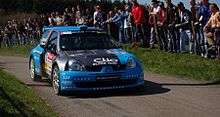Super 1600
Super 1600, also known as S1600, is a rally car formula that is primarily used in the Junior World Rally Championship, as well as various national rally championships. Any automobile manufacturer that has a suitable road-going production model in its range may develop a specification for use in this formula. It was devised by the Fédération Internationale de l'Automobile (the international governing body of motorsport) in 2000 and first saw competitive use in 2001. Super 1600 is intended to provide a young driver's entry point into international rallying, and the World Rally Championship in particular.
| Super 1600 | |
|---|---|
| Motor racing formula | |
| Category | Rallying |
| Country or region | International |
| Championships | Various |
| Inaugural season | 2001 |
| Status | Active |
| Current champions | Aaron Burkart. The 2010 winner of the Junior World Rally Championship |
Technical details

Eligibility
Most FIA-approved rally car formulae are in some way production-based, from Super 1600 to World Rally car specification. This necessitates a process of homologation in which a suitable production road car design is modified within the limits of a formula's technical regulations. Such changes may include modified or entirely new parts in the engine, gearbox, suspension, bodywork and so on. In the Super 1600 formula, "suitable" is defined as a passenger car that has one driven axle (two-wheel drive) and a 4-cylinder engine that is of naturally aspirated configuration with a maximum volume of 1640cc.[1] At the time of homologation, the car must currently or have previously been in serial production.[2]
The direct involvement of manufacturers is not necessary for homologation to be granted; in most forms of production-based motorsport, it is quite common for cars to be developed by independent constructors and specialist teams. Even official factory-supported development programs are often outsourced to an experienced third party. The Citroën C2 is an example of in-house development; the Ford Fiesta was developed by a contracted specialist (M-Sport); and the Opel Corsa was developed independently without assistance from GM.[3]
Modifications
The production car's standard gearbox is replaced by a sequential manual gearbox with a maximum of six forward ratios. The engine may be modified to produce a maximum power output of 230hp and the exhaust is subject to a noise restriction of 100dB at 4500rpm.[4]
As with the World Rally Car specification, Super 1600 requires a production-standard bodyshell that is made safe for competition with the addition of a roll cage. Certain other modifications can be made to increase the width of the bodywork and improve its aerodynamic efficiency. The weight of the competition car is reduced to a minimum of 980kg, with a lower minimum weight of 920 kg if an engine with only two valves per cylinder is employed.[5] In most cases, this is approximately 50 to 100 kg less than the weight of the production car version; the 1.6L Citroën C2, for example, weighs 1084 kg.[6]
Homologations
The following table shows the most notable S1600 cars that have competed at international level:
| Make | Model | JWRC wins [7] |
|---|---|---|
| Citroën | C2 | 22 |
| Suzuki | Swift | 15 |
| Citroën | Saxo | 10 |
| Renault | Clio | 10 |
| Suzuki | Ignis | 9 |
| Fiat | Punto | 3 |
| Ford | Puma | 1 |
| Volkswagen | Polo | 1 |
See also
- Super 2000, a specification and classification for production based race cars
- Group N, a set of regulations in motorsport for production vehicles
References
| Wikimedia Commons has media related to Super 1600. |
- Super 1600 Technical Regulations, 2006 Articles 4.1-4.4.
- Super 1600 Technical Regulations, 2006 Article 1.1.
- Corsa S1600 Specification corsasuper1600.com. Retrieved on April 21, 2007.
- Super 1600 Technical Regulations, 2006 Article 4.7.
- Super 1600 Technical Regulations, 2006 Article 12.
- C2 Technical Specifications citroen.co.uk. Retrieved on April 22, 2007.
- Seasons at World Rally Archive juwra.com. Retrieved on November 10, 2010.